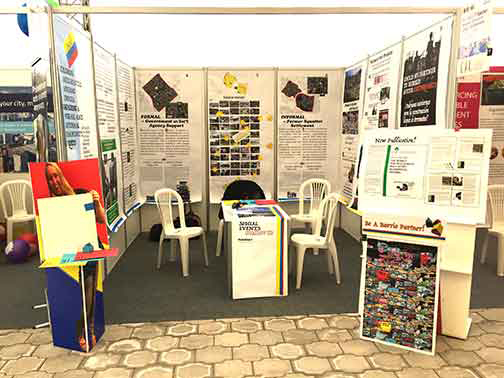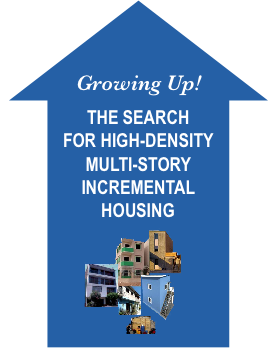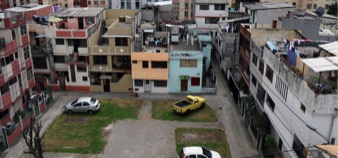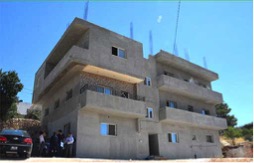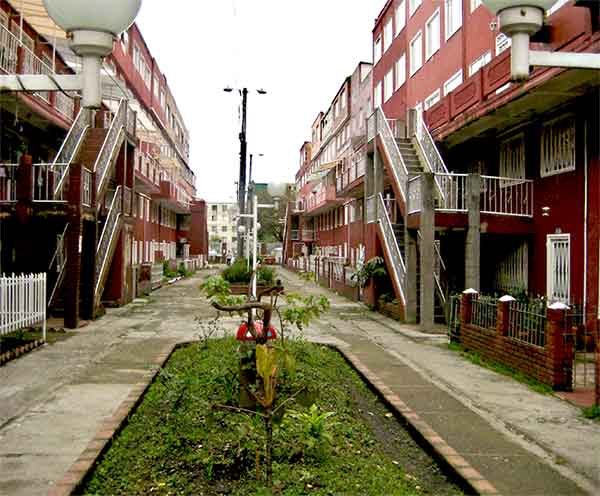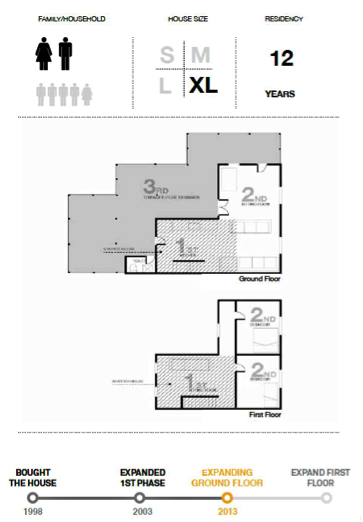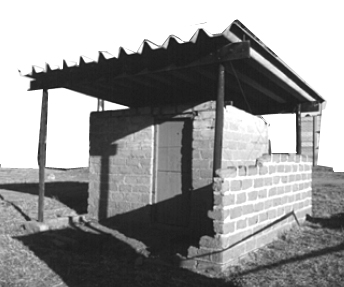| Title | Article Description |
|---|---|
INCREMENTAL HOUSING PROCESS - COMPARING A FORMAL AND INFORMAL COMMUNITY
HABITAT III SIGUS Exhibit Quito, Ecuador, October 2016
|
The exhibit highlighted and raised the question of informal vs formal development in providing housing for the low income. A key element was comparison of two settlements that started at the same time, both incrementally developed, one a squatter and the other a govt project supported by a $20 million USAID loan. |
Presentations of Build Examples at the Network Session at the UN World Urban Forum in Naples 2012SIGUS-MIT and TU Darmstadt |
Examples of multistory built incremental designs from El Salvador, Haiti, Egypt, Chile and an informal project in Peru, along with an introduction and an overview of incremental context and ending with brief comments related to the incremental design from the Naples workshop. Available on Amazon: GROWING UP - GOETHERT AND NOHN |
LAS CAJITAS DE FÓSFORO: THE SOLANDA HOUSING PROJECT Quito, Ecuador
Valeria Vidal and Francis Goyes
Special Interest Group in Urban Settlements (SIGUS)
|
An unprecedented initiative with four main innovations to the provision of affordable housing in Ecuador: introduction of incremental housing models, public-private partnerships, comprehensive community development programs, and institutional reforms for housing regulations. As an incremental housing experiment in 1980 by the government and USAID funding, the evolution of Solanda is a celebration of what people are capable of designing, financing and building. The research learns from the experience of families for the past 35 years to identify positive and negative policies that advance or deter affordable housing strategies today. Today 80,000 people live there, vastly surpassing the original population of 18,000 residents. Compare to Ciudad Bachue project in Bogota, Colombia |
REFUGEES, INCREMENTAL HOUSING, AND SHELTER IN THE 21ST CENTURY
Francis Goyes, Sera Tolgay, and Valeria Vidal
SIGUS; Massachusetts Institute of Technology
First Prize in Graduate Student Paper Competition ‘Reducing Urban Poverty Graduate Paper Competition’ co-sponsored by Cities Alliance, IHC - Global Coalition for Inclusive Housing and Sustainable Cities, USAID, the Wilson Center, and the World Bank. (Last year SIGUS researchers also won the first prize for study of change in IADB housing project in Manaus, Brazil.) Original Field Research |
The lack of adequate and affordable rental housing stock to accommodate an increasing number of Syrian refugees has put a strain on the capacity of cities in Northern Jordan. This paper examines the post-implementation impact of the incremental housing model of the Norwegian Refugee Council (NRC)’s Urban Shelter Program for assisting refugees in urban settings. NRC’s program provides financial assistance for house expansions and finishing to homeowners in exchange for rent-free accommodation to Syrian refugee families |
INCREMENTAL HOUSING PROJECT IN BOGOTA, COLOMBIA 1977:
|
CIUDAD BACHUE was considered a vanguard project by the government agency ICT, started in 1977 and featured single and multi-family progressively expanded units, 7,124 total. Initially at the periphery of the Bogota city center, and now well-connected by various public transit systems and engulfed by city expansion. The project combines 10 different housing prototypes all less than 100 m2: five types are single family, five are multi-family, ranging from 1 to 5-story. All intended to be expanded progressively, except for the 4 and 5-story buildings with duplex apartment on top. Study includes detailed observations of planned and unplanned expansions and recommendations for planning similar incremental multi-story housing projects. |
FIJI INCREMENTAL HOUSING CASE STUDIES:
|
EXTRACTS from the Fiji Workshop during the January Independent Activities Period, 2013. Cases are grouped into four categories: squatters, relocation projects, upgrading projects, and transformation examples.Also included from Workshop are Environmental Reflections (Heber), selected parallels from Latin America (Vargas) and examples of incrementalizing existing housing program types. |
CONSEJAS DE SANTIAGO:
STORIES FROM SANTIAGO, CHILE
|
An in-depth photographic study and brief overview of social housing projects in Santiago. Particular focus on four Elemental incremental projects (Pudahuel, Renca 1, Renca 3, and Lo Espejo) and three less contemporary housing (Conjunto Andalucia, Villa Portales, and Los Sauces. |
INCREMENTAL USER BUILT HOUSING: ELEMENTAL PROJECTS AND SIMILAR HOUSING IN SANTIAGO, CHILE |
This field research focused on Elemental and similar projects in Santiago, Chile. Three Elemental projects were visited, along with four similar housing projects. These projects are known worldwide for their successful incremental expansion design for multi-story housing |
THE ORGINS AND SPREAD OF CORE HOUSINGMark Napier, Programme Director, |
An overview of core housing as a major variant of the self-help technique. Introduced into the underdeveloped areas by United Nations missions, it has now become part of the housing vocabulary. It aims to provide an organised, cheap, and practical scheme for the urban and urbanising areas of poorer countries. Since the UN missions, the idea has spread and is on its way to becoming an important building device in the less developed areas. (Abrams, 1964:176) |
A LONG WAY HOME -
|
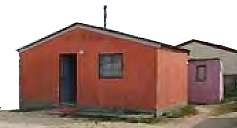
This article analyses the provision of core housing in Khayelitsha, South Africa. It covers the perspectives of families who have inhabited core housing plots for over two decades, with careful attention to household composition and both constraints and opportunities in the use of the plot form the point of view of the people themselves. Several strategies of how people have been able to realize the consolidation of their homes are discussed, including ingenuity in response to internal densification on the site.. |
THE EVOLVING RELATIONSHIP BETWEEN CLIMATE CHANGE AND SELF-HELP HOUSING
|
There is the need to recognize an evolving relationship between climate change and self-help. Because of climate change impacts – sea level rise, increased precipitation, rising temperatures and the increase in frequency and intensity of natural disasters – self-help as it is currently practiced will be challenged. Of necessity, self-help remains the principal tool of low- and middle-income families to address their shelter needs. Climate change will change the shape, densities and infrastructure of cities that will affect low-income families. It will also increase the vulnerabilities of communities located on marginal land. |
SITE AND SERVICES OF THE 21st CENTURY - WE HAVE BEEN THERE BEFOREReinhard Goethert Symposium presentation: Metropolis Nonformal – Anticipation Munich , November 20-23, 2013 |
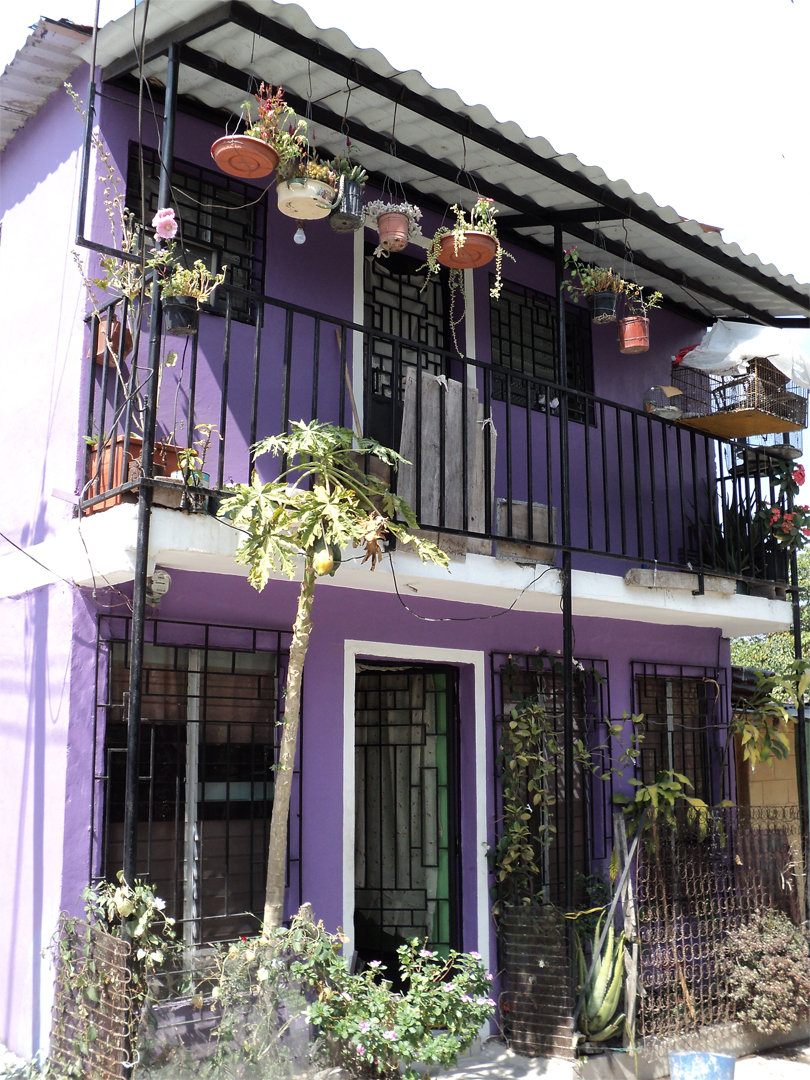 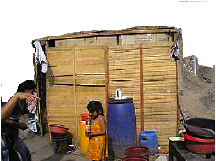
Informal builders provide the bulk of affordable housing and define large areas of our cities. Long considered as poor and unable to house themselves, over time the resultant informal housing generally matches higher income standards but clearly outbuilds the formal sector by a large fator. This incremental process has been adopted by governments into programs, originally called ‘site and services’, focusing on housing and land development, and embracing the process as the key characteristic. A methodology to capture this process has been developed which offers a base for developing effective policies in supporting the incremental builders. (See also complete listing of presentations with videos of the Munich Symposium: http://www.tum-ias.de/metropolis-nonformal-symposium/presentations.html) |
INCREMENTAL HOUSING - THE NEW SITE AND SERVICESReinhard Goethert
|
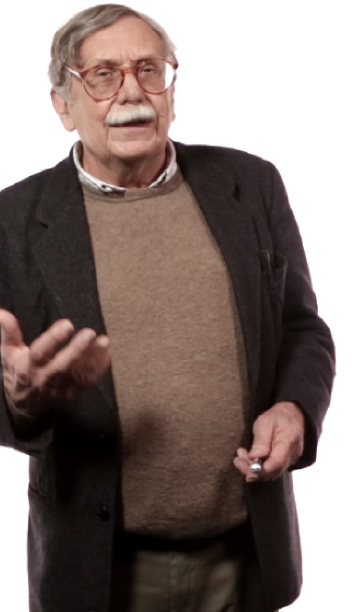
The rapid urban population surge of the 60s driven largely from migration with resultant massive unauthorized city expansion provided challenges in finding effective housing interventions. Upgrading programs became widespread despite high monetary and spatial costs. This brief overview focuses on a mimic of the informal housing process which offered a direction for policy, adopted in the 70s by development agencies worldwide and known as ‘site and services’. |
TRANSFORMATIONS OF A PUBLIC HOUSING PROJECT IN INDIA – Janpura Extension, New Delhi. Architectural Record, 'Third World Housing', August 1985. Solomon Benjamin |
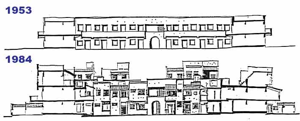
The official bureaucratic approach to providing shelter has been proved inadequate time and time again. Without official help, the inhabitants of Janoura Extension have transformed their government-provided block into a dense habitat for a varied community. |
TRANSFORMATIONS OF PUBLIC HOUSING IN CHINA – Davuan Compound, Beijing, 2012
|

Photographic essay of a Danwei. The Beijing No.2 Textile Factory Residential Compound was built in 1950s as a Danwei (work unit)/ Dayuan (essentially a big gated community) following the Soviet model. It is located in the southeast of Beijing. A Dayuan is the dominant urban and social form of China from early 1950s to late 1970s. The incremental transformation is believed to be relatively recent. |
EXAMINING USER-INITIATED TRANSFORMATIONS IN GOVERNMENT HOUSING IN MANAUS – HIGH DENSITY INCREMENTAL EXPANSION
|
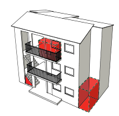
Study of recently completed project funded by the InterAmerican Development Bank in Manaus, Brazil. Although the original plans to build walkups that would be modified by the users were abandoned, the researchers surveyed the informal changes made by the families in the completed units after occupation since 2007/2009. Findings included extensive additions to storage spaces, living spaces, and a considerable number of home-based enterprises.
The paper includes detailed description of modifications and additions, and follows with an incremental walkup model with estimated cost sharing by government and families, and guidelines for future housing.
|
INFORME PROYECTO - SELF HELP HOUSING & INCREMENTAL HOUSING - THE LIKELY DIRECTIONS FOR FUTURE HOUSING POLICY. SANTIAGO JUNIO 2011 (SPANISH ORIGINAL) – Prof. Margarita Greene Z; Facultad de Arquitectura, Diseño y Estodios Urbanos, Pontificia Universidad Católica de Chile. mgreenez@uc.cl |
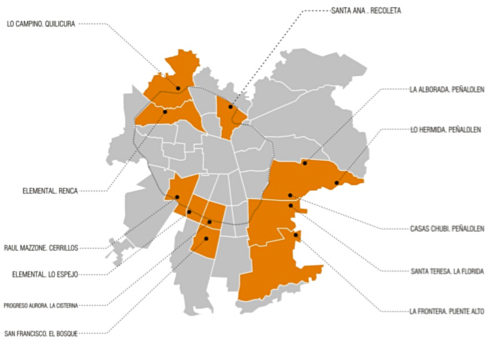
The ultimate objective of this study is to provide policy options for governments, national and local level, to create environments that support incremental housing processes. Santiago, Chile, is the base for the study. The study tests two hypotheses. The incremental process, both formal and informal, can be substantially improved in terms of speed of consolidation and construction quality, benefiting both affected families and the city. The second, to support housing programs built incrementally is a proactive approach efficient in terms of costs, administrative and technical inputs, and increases affordabile housing units. Three types of incremental construction were identified: 1) Informal construction. Self-help housing with no, or very little government support, from informal settlements built by the homeless on the outskirts of large cities. 2) Planned Incremental. This type includes the Progressive Housing Program (PVP) and the Housing Solidarity Fund (FSV). Both programs provide a solution initially modest to be extended and completed by the beneficiaries themselves. And 3) Unplanned Incremental. This type includes incremental activity carried out without government help and usually without external support, having received a small finished house. Both growth and improvement are seen. This type includes the Basic Housing Program which was a massive program for the poor that began in the 80's. A sample of families in eleven districts were surveyed, reflecting different governmental actions, which correspond to the three types of incremental action. A total of 210 families were surveyed in early 2011. (View/Download PDF) |
| 'YOUNG TOWN' GROWING UP: FOUR DECADES LATER: SELF-HELP HOUSING AND UPGRADING LESSONS FROM A SQUATTER NEIGHBORHOOD IN LIMA - Susana Williams, MIT Thesis, 2005 SRojasWilliams@habitat.org |
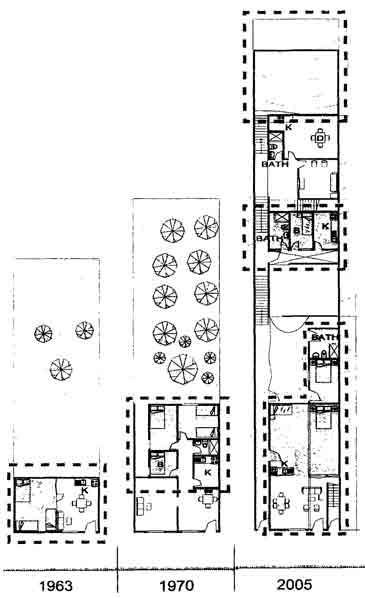
This thesis examines self-help housing policies in Peru by revisiting Independencia, one of Lima's young towns (squatter settlements), forty-five years after its founding. The study was designed to better understand how Independencia's low and moderate income families have been able to access and upgrade their housing from a long-term perspective. The thesis has three objectives: 1) to explore the different factors that influenced housing investments by the poor in Independencia; 2) to understand how programs created to support housing, have in fact contributed to or served as resources for families in Independencia; and 3) to understand how this process has worked and whether it is still able to meet the housing needs of families in Independencia. An underlying issue is the nature of incremental housing and progressive self-managed development. The house is perceived as a process and not as a final product. Using the housing trajectory as the unit of analysis, it is possible to see how this model has worked, how investments were made (building process), why investments were made and what provided the opportunities (influential factors). Based on findings from the data collected from thirty-one family interviews and housing surveys, the conclusions consider the role of external factors (public services, public infrastructure investments, land tenure, micro-credit, etc) and internal factors (family income and demographics) in housing investments over the forty-five years of its growth. Findings suggest that multi-generational needs are not being met and new forms of ownership, legal tenure, new credit, financing mechanisms and technical assistance are required. |
| CORE HOUSE OPTIONS AND POSSIBLE BUILDOUTS George Gattoni. Fall 2009. |
 Core house options and possible buildouts. (View Diagrams) Core house options and possible buildouts. (View Diagrams) |
| MKALLES HOUSING PROJECT - Beirut Urban Area
Omar Take, Horacio Caminos, Reinhard Goethert. |
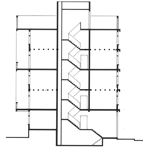 The Mkalles Housing Project was the first public housing proposal in Beirut. It was commissioned by H.S. the President of Lebanon, Suleiman Bey Frangie by presidential decree, through the Ministry of Housing and Cooperatives. (summer 1973)
The preliminary design was prepared by staff and graduate members of the Urban Setlement Design Program in the School of Architecture at MIT during the Fall 1973. Mr. Omar Take presented the design to the Ministry officials and a further presentation was made at the Presidential Palace.
The design incorporates a range of building types, offering incremental expandability through interior additions of floors, and a clustered arrangement of dwellings in the interior to support smaller community groupings.
The project was cancelled due to the increasingly unstable situation in Beirut
. (View more) The Mkalles Housing Project was the first public housing proposal in Beirut. It was commissioned by H.S. the President of Lebanon, Suleiman Bey Frangie by presidential decree, through the Ministry of Housing and Cooperatives. (summer 1973)
The preliminary design was prepared by staff and graduate members of the Urban Setlement Design Program in the School of Architecture at MIT during the Fall 1973. Mr. Omar Take presented the design to the Ministry officials and a further presentation was made at the Presidential Palace.
The design incorporates a range of building types, offering incremental expandability through interior additions of floors, and a clustered arrangement of dwellings in the interior to support smaller community groupings.
The project was cancelled due to the increasingly unstable situation in Beirut
. (View more) |
| TYPOLOGY OF STARTER BASES FOR INCREMENTAL EXPANSION Urban Settlement Design Program, MIT. |
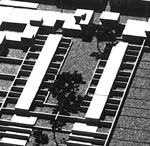 Typology of starter bases for incremental expansion. (View More) Typology of starter bases for incremental expansion. (View More) |
| 164 MORE CORE HOMES BEING BUILT COUNTRYWIDE Guyana - Guyana CHRONICLE Online. Monday, 16 January 2012 |
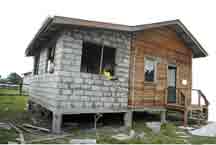
Brief article showing examples of the recent ‘core homes’ built by the government of Guyana, Latin America. The program targets 400 houses to be built throughout the country. |
SELF-HELP AND INCREMENTAL HOUSING EL SALVADOR: LIKELY DIRECTIONS FOR FUTURE POLICY With the Fundación Salvadoreña de Vivienda Minima (FUNDASAL) |
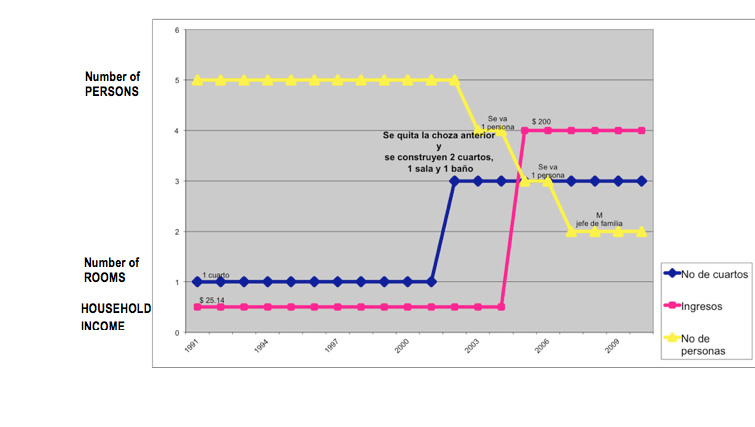
The report documents a forty-year longitudinal case study of incremental housing in El Salvador. The purpose is to follow and understand how low-income households have built their houses over time. A survey of 210 households documented the strategies and processes from occupation to the present – most of the cases spanning three decades. Seven settlements were surveyed, representing three predominant types of low-income housing in El Salvador – illegal settlements, ‘sites-and-services’ projects, and ‘turnkey’ housing projects by government and the private sector. |
| EARLY RESULTS FROM SAVDA GHEVRA FIELD WORK, DELHI – Julia King |

In the Savda Ghevra resettlement colony on the fringes of Delhi, the building typology is characterized by a process that is not planned - where houses are invested in and built over time by individuals, families and social networks, that are the result of social and functional needs, climate and available resources, materials and technology. Ongoing research looks at sharing and building technology for low income housing in regularized settlements - investigating the relationship between incremental growth and community sharing and identifying the advantages and disadvantages of such incremental construction. The research has lead to a decentralized sanitation building project within Savda Ghevra colony. (View/Download PDF) |
| SEMINAR PROCEEDINGS
CORE HOUSING AND SITE AND SERVICES PROJECTS
FOR LOW INCOME GROUPS. - Dr. Reinhard Goethert, MIT; Dr. Zakia Shafie, Cairo University |
 The joint Cairo University/MIT research team on housing, under the auspices and with the cooperation of the Ministry of Housing and the Ministry of Development and New Communities, held a seminar January 1979, in Cairo, Egypt, bringing together all the proposed projects for core housing at that time. The report includes a descriptive summary of each of the projects along with the concepts of their designs. (View/Download PDF) |
| HOUSING POLICY MATTERS FOR THE POOR
LATIN AMERICAN EXPERIENCES WITH URBAN HOUSING. - Eduardo Rojas, InterAmerican Development Bank |
 An overview of the housing situation in Latin America. A presentation at the Massachusetts Institute of Technology, April 11, 2011. Includes the experience of incremental housing, especially in Chile. (View/Download PDF) |
| FACILITATING COMMUNITY DEVELOPMENT WITH HOUSING MICROFINANCE – APPRAISING HOUSING SOLUTIONS FOR PAKISTAN AFTER DISASTERS - F. Tariq, College of Design, North Carolina State University, USA |
After the deadly floods and earthquakes, more than two third Pakistanis were in urgent need of assistance. The scope of destruction is so wide that instead of huge international donations and government efforts for relief and reconstruction, the situation is not healing effectively and the gap is enlarging day by day. There is an urgent need for policy change in Pakistan towards innovative housing strategies including financial and technical assistance programs. Incremental housing may be one option to consider. (View/Download PDF) |
| INCREMENTAL HOUSING ARTICLE, MONDAY MAGAZINE - Reinhard Goethert, on behalf of the Global University Consortium |
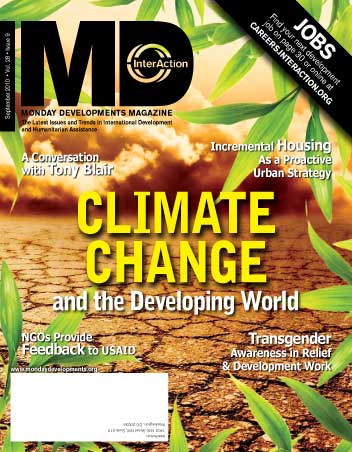 Here is a frightening fact: the urban population in the developing world will double by 2030. The implications are staggering. One is that we have 20 years to build as much urban housing as was built in the past 6,000 years. Clearly we cannot continue as in the past; issues of speed and scale have become even more critical, and disasters only heighten the challenges. A process known as incremental housing can be a key part of the solution. A recently formed Global University Consortium is promoting the approach and makes information available. (View/Download PDF) |
| Incrementalize It! - Reinhard Goethert + Chris Malcolm |
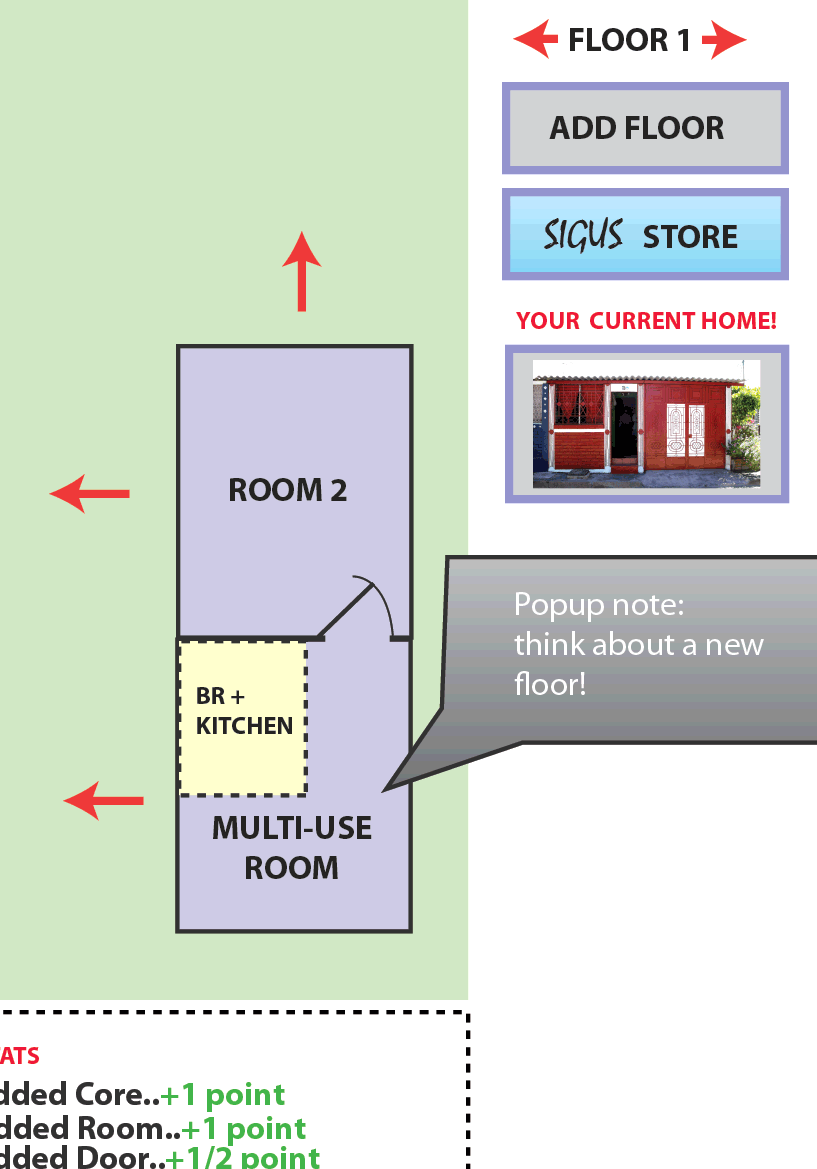 Incrementalize It! is a game to highlight the implications of incremental housing. It covers how it works and what are some aspects to keep in mind when making decisions. This includes where to put a starter core, how/where to expand, what materials one should use, etc. This game is not only for the homeowner, but the designer as well. The person expanding their house can benefit just as much as the person deciding on policy and designing projects. The game intends to promote the familiarly and use of core housing, particularly for developing countries where core housing would be an a vital proactive housing option by governments. Currently the game is in the first phase of development, and initially it will be available on the web. SIGUS intends to bring this tool to the mobile platform for boarder availability, for both Android and Apple-based APPs.(View/Download PDF) |
| ARANYA, INDORE, INDIA | 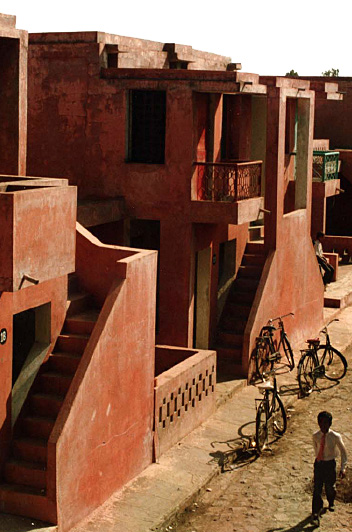 Aranya, 6 kilometres from Indore, will house a total population of 60,000 in 6500 dwellings on 85 hectares. The master plan prepared by the Vastu-Shilpa Foundation in 1983, is designed around a central spine comprising the business district, with six sectors of 7000-12,000 population each. Ten houses, each with a courtyard form a cluster. Internal streets and squares are paved. Septic tanks are provided for groups of twenty houses, and electricity and water are available throughout. The site plan accommodates a variety of income groups. The poorest are located in the middle of each of the six sectors, while the better off obtain plots along the peripheries and the central spine. Payment schemes, and a series of site and service options, reflect the financial resources of this mixed community. Eighty demonstration houses displayed a wide variety of possibilities, ranging from one room shelters to relatively spacious houses. Available to the poorest, in addition to the plot itself, are a concrete plinth, a service core, and a room. (1-SUMMARY, 2-BUILT FORM, 3-DETAILS, 4-POST-OCCUPANCY ) Aranya, 6 kilometres from Indore, will house a total population of 60,000 in 6500 dwellings on 85 hectares. The master plan prepared by the Vastu-Shilpa Foundation in 1983, is designed around a central spine comprising the business district, with six sectors of 7000-12,000 population each. Ten houses, each with a courtyard form a cluster. Internal streets and squares are paved. Septic tanks are provided for groups of twenty houses, and electricity and water are available throughout. The site plan accommodates a variety of income groups. The poorest are located in the middle of each of the six sectors, while the better off obtain plots along the peripheries and the central spine. Payment schemes, and a series of site and service options, reflect the financial resources of this mixed community. Eighty demonstration houses displayed a wide variety of possibilities, ranging from one room shelters to relatively spacious houses. Available to the poorest, in addition to the plot itself, are a concrete plinth, a service core, and a room. (1-SUMMARY, 2-BUILT FORM, 3-DETAILS, 4-POST-OCCUPANCY ) |
| The Case for Incremental Housing - Pat Wakely |
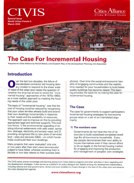 Over the last two decades, the failure of standardised contractor led housing delivery models to respond to the sheer scale of need of the urban poor raises the question of whether the time has arrived to revisit the "incremental housing" approaches of the 1970s–1980s as a more realistic approach to meeting the housing needs of the urban poor. (View/Download PDF) Over the last two decades, the failure of standardised contractor led housing delivery models to respond to the sheer scale of need of the urban poor raises the question of whether the time has arrived to revisit the "incremental housing" approaches of the 1970s–1980s as a more realistic approach to meeting the housing needs of the urban poor. (View/Download PDF) |
| The Case for Incremental Housing (Expanded article). Prepared for the Cities Alliance, June 2011. - Patrick Wakely and Elizabeth Riley |
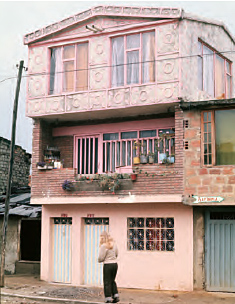 Expanded, full version of the article making the case for incremental housing. A noted by the Introduction by John Turner: "The study makes an irrefutable six-fold case or realizing the full potential of a most successful way of building. It describes procedures by which millions of low-income people develop their homes and neighborhoods, often to surprisingly high standards." (View/Download PDF) Expanded, full version of the article making the case for incremental housing. A noted by the Introduction by John Turner: "The study makes an irrefutable six-fold case or realizing the full potential of a most successful way of building. It describes procedures by which millions of low-income people develop their homes and neighborhoods, often to surprisingly high standards." (View/Download PDF) |
| CASA ANDREA: TRANSFORMACION DE LOS ASENTAMIENTOS IRREGULARES Y LA AUTOCONSTRUCCION DE VIVIENDA, MORELOS, MEXICO. (Transformation of settlements and self-help housing, Morelos, Mexico) Prof. Mtra. Arq. Isabel Vargas Mata mvargas_mata@hotmail.com Arq. Jose Javier Rivera Islas; Arq. Marisol Rodriquez Sotelo |
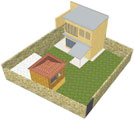 The transformation of the house of Andrea in the Ruben Jaramillo Settlement. Detailed data of the expansion since 1973. Poster format; includes process diagram of family size linked to house expansion. (View/Download PDF) The transformation of the house of Andrea in the Ruben Jaramillo Settlement. Detailed data of the expansion since 1973. Poster format; includes process diagram of family size linked to house expansion. (View/Download PDF) |
| LOW-COST HOUSING PROJECTS IN 6TH OF OCTOBER NEW TOWN, EGYPT – INTERNAL FLEXIBILITY Cairo University: Prof. Dr. Nasamat Abd El Kader Prof. Dr. Sayed Mohammed Ettouney Prof. Dr. Rowaida Reda Kamel Ass't. Dr. Reeman Mohammed Rehan |
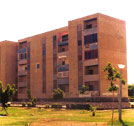 The project of Low-Cost Housing Prototypes in Egypt (1987) is one of the governmental trials to solve the Egyptian housing problem to reach a greater number of lower – income families. The concept offered internal flexibility of the housing unit, permitting the participation of the user in the design decisions that matches his needs and affordability.The partially completed housing prototypes offered seven types of five-story walk-ups apartments providing a variety of flat areas: 45, 60, 75 and 90 square meters. Each flat was conceived as a minimal shelter with a finished bathroom, structure elements, all sanitary connections and electrical installations. Internal partitions as well as walls and floor finishing were left, to be gradually completed by the user according to his needs and affordability. The project of Low-Cost Housing Prototypes in Egypt (1987) is one of the governmental trials to solve the Egyptian housing problem to reach a greater number of lower – income families. The concept offered internal flexibility of the housing unit, permitting the participation of the user in the design decisions that matches his needs and affordability.The partially completed housing prototypes offered seven types of five-story walk-ups apartments providing a variety of flat areas: 45, 60, 75 and 90 square meters. Each flat was conceived as a minimal shelter with a finished bathroom, structure elements, all sanitary connections and electrical installations. Internal partitions as well as walls and floor finishing were left, to be gradually completed by the user according to his needs and affordability. The concept was welcomed as it combined the external appearance of a complete building and allowed the users to gradually complete and finish the interiors of their dwellings. (View/Download PDF) |
| A Brief Overview of Incremental Housing Construction In Kathmandu Valley, Nepal - Biresh Shah |
The phenomenon of Incremental Development of housing has an interesting development in Kathmandu valley. In the past (until the 50’s), when construction was limited to brick walls in mud mortar and the building had to be topped with a sloping roof of tiles to prevent monsoon seepage, the preferred house type was the single and double bay three-story construction with a sloping roof of tiles (or sometimes thatch) and CGI sheets. As land was more readily available, extension took place horizontally as complete wings were added to the original house. This was done largely to accommodate expanding extended families. This form also allowed for the creation of a variety of open spaces (forecourts, subcourts, courtyards) around the house in a neighborhood as new wings were added to existing bocks, and used for a variety of activities. (Read More) |
| Incremental Housing: The Past and Future Dwelling Solution for the Poor - Roberto Chávez, Housing Expert |
This paper briefly examines three case studies of incremental housing programs that took place over three decades in Latin America, Africa and North Africa. Incremental housing begins at its most elemental with the land, usually in the form of surveyed or irregularly occupied plots. Surveyed are the most basic form of sites and services and arguably the least-cost housing solutions that are based on the principles of self-help and mutual aid in settlements that can be easily upgraded. This paper also maintains that the most basic infrastructure networks that can enhance surveyed plots programs is a street addressing system. Addressed surveyed plot programs are therefore the most cost effective tool to harness the energy and creativity of over 1,000,000,000 urban residents that will be added to developing cities in the next two decades, and thus prevent the generation of 600,000 square kilometers of new slums. (Read More) |
| REFLECTIONS ON THE LA PRESITA SURVEYS San Miquel, El Salvador A revisit to a legacy ‘Site and Services – Core House’ project developed in the 1970s |
During a three-day day survey of La Presita, El Salvador, January 2008, our team found an economically active community that is considered desirable to live in, whose properties have high value, with a strong and successful built environment. It continues to provide affordable and high-quality housing for original families; however, this same affordability does not extend to new buyers. We also found the community struggling with gang activity, a lack of financing to improve or maintain infrastructure, poor service and political governance from the municipal level, and properties left vacant by out-migration. We also found that the social organization of the community, strong at its founding, has eroded over the years. What follows is an overview of our visit and general profile of the community, as well as a description of our impressions related to four topics: construction and materials, urban design and infrastructure, social organization, and household finances. We conclude with what we see as opportunities for interventions in La Presita or to consider in the planning of future such projects. (Read More) |
| A Case for the Incremental Housing Process in Sites-and-Services Programs And Comments on a New Initiative in Guyana - George Gattoni July 7, 2009 |
Worldwide, urbanization is a process in which both cities and low-income residents build incrementally: cites expand and improve infrastructure as populations grow; people construct houses as they can afford, one room at a time, to have a better place to live. Both advance as resources, regulations, bureaucracies, markets and costs allow. City governments look for ways to guide and control the processes, often with mixed results. In countries where government policies and practices don’t take into account the needs, rights and abilities of low-income groups, housing deficits increase. The outcomes are illegal squatter settlements and slums: the only options available to the poor. For half a century developing countries have struggled with the issues of low-income housing - at best trying industrialized, public housing models (expensive and ill-fitting) with little success; at worse, bulldozing informal settlements, thus displacing thousands of residents with few or no alternatives. (Read More) |
| Survey of Incremental Growth in Cuevas, Former Squatter Community, Lima, Peru. FAUA-UNI and SIGUS-MIT Taller. sigus@mit.edu |
Survey of three types of incremental expansion: 'Consolidadas', 'Nuevas', and 'No Consolidadas'. Summarized on a chart linking time, expansion, family size, and income. (View/Download PDF) |
| Survey of Incremental Growth in El Agustino, Former Squatter Community, Lima, Peru. FAUA-UNI and SIGUS-MIT Taller. sigus@mit.edu |
Survey of three types of incremental expansion, summarized on a chart linking time, expansion, family size, and income. (View/Download PDF) |
| Survey of Incremental Growth in El Ermitano, Former Squatter Community, Lima, Peru. FAUA-UNI and SIGUS-MIT Taller. sigus@mit.edu |
Survey of five examples of incremental expansion, summarized on charts linking time, expansion, family size, and income. (View/Download PDF) |
| Reaching Low-income Families: The Housing Improvement System in Ecuador - Daphne Frank, GTZ |
 Ecuador’s government initiated a nationwide program called the Housing Incentive System – Sistema de Incentivos para la Vivienda (SIV) in 1998 which ran until 2005. This program consisted of two components, one oriented towards the construction of new housing and another for the improvement of existing self-built houses. The latter component is considered as it was aimed at low-income groups. The Ministry for Urban Development and Housing - Ministerio de Desarrollo Urbano y Vivienda (MIDUVI) rewarded savings by means of a single premium awarded to families in need of assistance. Within the new housing component, a voucher known as the 'Bono para Vivienda Urbana Nueva' financed up to 75% of the value of the new construction, with a maximum subsidy of US$1,800. These vouchers were aimed only at middle-income families. (Read More) Ecuador’s government initiated a nationwide program called the Housing Incentive System – Sistema de Incentivos para la Vivienda (SIV) in 1998 which ran until 2005. This program consisted of two components, one oriented towards the construction of new housing and another for the improvement of existing self-built houses. The latter component is considered as it was aimed at low-income groups. The Ministry for Urban Development and Housing - Ministerio de Desarrollo Urbano y Vivienda (MIDUVI) rewarded savings by means of a single premium awarded to families in need of assistance. Within the new housing component, a voucher known as the 'Bono para Vivienda Urbana Nueva' financed up to 75% of the value of the new construction, with a maximum subsidy of US$1,800. These vouchers were aimed only at middle-income families. (Read More) |
| SKETCHES FROM INFORMAL FIELD SURVEYS IN THE TONDO REGION OF METROPOLITAN MANILA - Non Arkaraprasertkul |
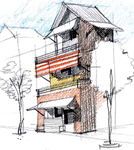 Sketches from informal field surveys in the Tondo Region of Metropolitan Manila. Focus on older low income housing projects and recent projects of the Gawad Kalinga NGO (GK). JANUARY 2006 - Source: Reflections from the Manila Workshop. SIGUS-MIT, 2006. City has “memory” and it is this memory that makes each city a place for people. City, as a case study of urban settlement in the Southeast Asian –in this case, Manila-- is vibrant because it has a true sense of authenticity, culturally and socially. The Philippines today is experiencing unprecedented urban transformation through a process of global urbanization. Southeast Asian urban growth is different from its Western counterparts. What was proposed and determined upon considerations manifested back in 1796 must be traced via its historical and theoretical trajectory, with an intensive understanding of the essence of urban culture. (View/Download PDF) Sketches from informal field surveys in the Tondo Region of Metropolitan Manila. Focus on older low income housing projects and recent projects of the Gawad Kalinga NGO (GK). JANUARY 2006 - Source: Reflections from the Manila Workshop. SIGUS-MIT, 2006. City has “memory” and it is this memory that makes each city a place for people. City, as a case study of urban settlement in the Southeast Asian –in this case, Manila-- is vibrant because it has a true sense of authenticity, culturally and socially. The Philippines today is experiencing unprecedented urban transformation through a process of global urbanization. Southeast Asian urban growth is different from its Western counterparts. What was proposed and determined upon considerations manifested back in 1796 must be traced via its historical and theoretical trajectory, with an intensive understanding of the essence of urban culture. (View/Download PDF) |
| COMPARISON OF CORE HOUSE DESIGNS IN EGYPT NEW TOWNS - Dr. Zakia Shafie, Cairo University, with Teaching Assistants Ahmed H. Sherif and Tolba Ragab Tolba |
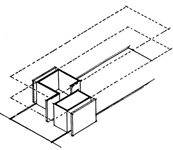 This paper compares and evaluates the core house design proposals in their context as a proper building type for low income people. A detailed assessment of their characteristics and an analytical review of their potentialities is undertaken. From each of the proposed core houses in Egypt two examples were selected from the forementioned planning, design, or research groups; one small lot situation and one large lot situation. (View/Download PDF) This paper compares and evaluates the core house design proposals in their context as a proper building type for low income people. A detailed assessment of their characteristics and an analytical review of their potentialities is undertaken. From each of the proposed core houses in Egypt two examples were selected from the forementioned planning, design, or research groups; one small lot situation and one large lot situation. (View/Download PDF) |
| INCREMENTAL HOUSING IN THE CITY OF ALEPPO -
SYRIA - Architect Majed Al-Bean |
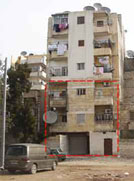 Starting from the 70s, in the last century the city of Aleppo grew dramatically till the population reached 2.5 million. More than 40% of the population is living in informal settlements, about 1 million people. Studies show that there are 22 informal settlements surrounding the city on the south, east and north. The city grew dramatically because of migration from surrounding rural areas and other cities. The housing demand grew more than five times but land availability in the real estate market was limited. Because city planning could not keep up with the rapid rise in population, the solutions came through the following two ways: (1) Illegal vertical expansion of existing buildings in some areas within the city planning zones. (2) The division of agricultural land surrounding the city with illegal construction. As a result during the past thirty years, 22 ‘irregularities’ around the city appeared, often called the ‘Ring of Poverty.’ Studies show that “the informal settlements are currently growing at some 4.0% per year. That represents 48,000 people per year or 8,000 households per year - requiring some 150 new dwellings per week in informal settlements.” (View/Download PDF) Starting from the 70s, in the last century the city of Aleppo grew dramatically till the population reached 2.5 million. More than 40% of the population is living in informal settlements, about 1 million people. Studies show that there are 22 informal settlements surrounding the city on the south, east and north. The city grew dramatically because of migration from surrounding rural areas and other cities. The housing demand grew more than five times but land availability in the real estate market was limited. Because city planning could not keep up with the rapid rise in population, the solutions came through the following two ways: (1) Illegal vertical expansion of existing buildings in some areas within the city planning zones. (2) The division of agricultural land surrounding the city with illegal construction. As a result during the past thirty years, 22 ‘irregularities’ around the city appeared, often called the ‘Ring of Poverty.’ Studies show that “the informal settlements are currently growing at some 4.0% per year. That represents 48,000 people per year or 8,000 households per year - requiring some 150 new dwellings per week in informal settlements.” (View/Download PDF) |
